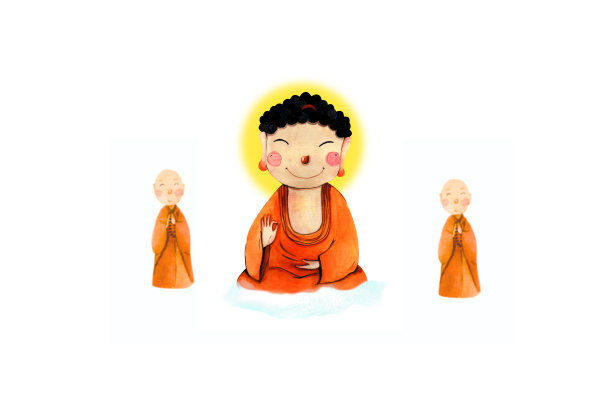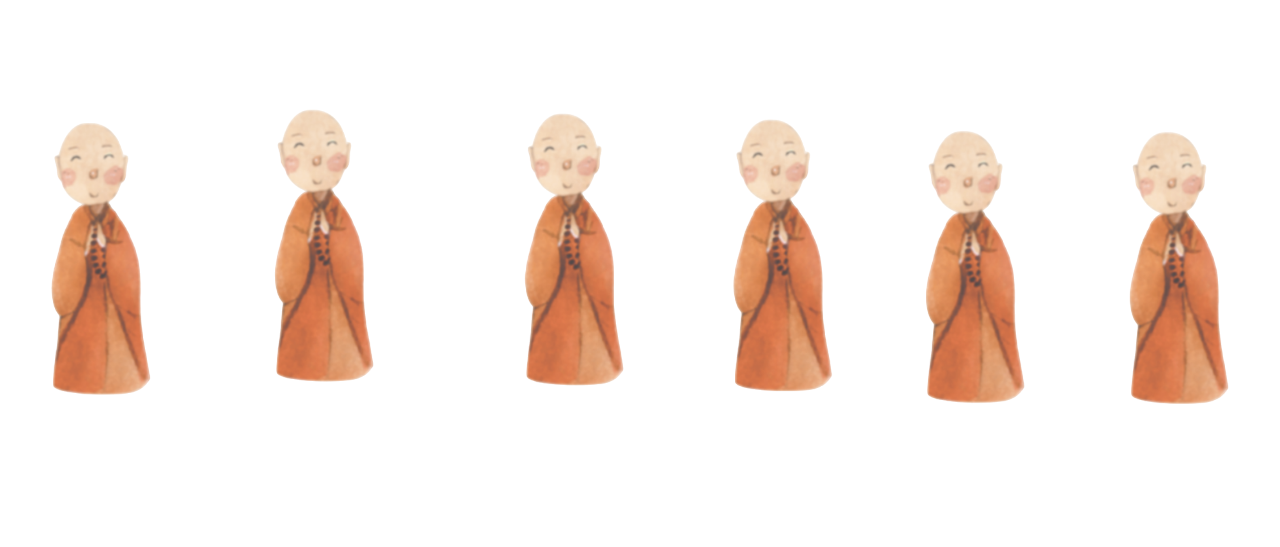Special Topics
One Buddha Flanked by Two Disciples
An introduction to combinations of Buddhist statues – One buddha flanked by two disciples In addition to flanking bodhisattvas, we occasionally can see statues of two disciples on each side of Sakyamuni Buddha. Who are these disciples?
In addition to flanking bodhisattvas, we occasionally can see statues of two disciples on each side of Sakyamuni Buddha. Who are these disciples?In the one-Buddha-flanked-by-two-disciple arrangement, the Buddha's flanking attendants are normally Śāriputra and Maudgalyayana in the Theravada tradition. On the other hand, in the Northern Buddhist tradition, these two positions are occupied respectively by Kāśyapa, known as the foremost in ascetic practices; and Ānanda, the foremost in memorizing the Buddha's teaching.
According to the Chapter on the Questions Raised by the Crowd in the Mahāyāna Mahāparinirvāṇa Sūtra, before the Buddha's parinirvana, he noted, "My most senior Dharma heir is Mahākāśyapa. Ānanda, on the other hand, being diligent in his practice, is capable of dispelling all doubts. You all shall learn from them attentively as Ānanda is the most learned." In other words, the diligence and the extensive knowledge of each of the two great disciples remind us that both understanding and practice, are both indispensable, just like the two wings of a bird or the two wheels of a car.
In addition, as mentioned in Chapter Two: Flower Picking in the Sūtra of Mahābrahmā's Consultation with the Buddha (大梵天王問佛決疑經), at the assembly on Vulture peak: when the Buddha picked a flower before everyone, all the participants looked at each other in confusion, except for Kāśyapa, who looked at him with a smile. The Buddha then told them, "I have a treasury of the true Dharma-eye and the marvelous mind of nirvana. Since reality is formless, there is a subtle and marvelous Dharma approach not being established on words and letters. It is an exceptional transmission that lies beyond doctrinal teachings. By upholding it, unenlightened ordinary beings can attain Buddhahood. The transmission of the ultimate truth is now entrusted to Mahākāśyapa." Venerable Kāśyapa thereby became the first to receive Dharma transmission from the Buddha. After the Buddha's parinirvana, Venerable Kāśyapa transmitted the Dharma to Ānanda, who thus became the Second Patriarch of the Dhyana School in India. Thereafter, the teachings had been passed for 28 generations down to Bodhidharma, who brought the teaching of dhyana to China and thus became the First Patriarch of the Chinese Chan Buddhism.
Regarding the arrangement of statues of the two disciples, it is usually with Kāśyapa on the left and Ānanda on the right. As flanking attendants of the Buddha, the image of an arhat is generally bald and robed, with palms joined to show veneration and adherence to the Buddha's teachings. The exception would be that of Venerable Kāśyapa, who is mostly depicted with clenched fists.
Long ago, after Vipassī Buddha's parinirvana, his disciples took his relics and made a pagoda with a statue of the Buddha in it. However, there was a slight defect on this golden statue. At that time, there was a poor woman who acquired a gold bead while begging. Intending to use the bead for repairing the statue, she then asked for the help from a gold forger, the previous incarnation of Venerable Kāśyapa. Understanding her wish and praising her meritorious deed, the forger then helped repair the defect. This good cause for adorning a Buddha statue enabled Kāśyapa to be born into noble and wealthy family life after life, and with great radiance emitting from his body. To cover the light in his hands, the Venerable therefore kept his fists clenched to show humility.

Kāśyapa and Ānanda
Kāśyapa, also known as Mahākāśyapa (Great Kāśyapa), was born into a Brahmin family. He took refuge in the third month after the Buddha's attainment of enlightenment, and practiced diligently, attaining arhatship before long. He was honorably referred to as being "foremost in ascetic practices" because of his constant practice of austerities in isolation. He was respected and trusted by the Buddha for his integrity. After the Buddha's parinirvana, Venerable Kāśyapa convened 500 arhats to preserve the Buddha's sayings, leading to the First Buddhist Council (saṅgīti).
Ānanda was born into a royal family and was the Buddha's cousin. He was good-looking, intelligent, knowledgeable, and had exceptional memory. He was thus honored as being foremost in "having heard much on the truth (bahussuta)." However, during the Buddha's lifetime, Ānanda had not yet attained arhatship. It was only after the Buddha's parinirvana that Ānanda, urged by Venerable Kāśyapa, practiced even harder and finally attained enlightenment. During the First Buddhist Council, it was Ānanda who recited the complete teachings of the Buddha, making a great contribution to the propagation of the Dharma.
Related articles:
Buddhas and Bodhisattvas in the Pure Lands
The Triad of Sakyamuni Buddha
Three Saints of the Ghanavyūha
Three Saints of the Western Pure Land
Three Saints of the Eastern Pure Land
Buddhas of the Three Times
One Buddha Flanked by Two Disciples
Resource: Issue 402 of Humanity Magazine, Dharma Drum Publishing Corporation
Translation: Sinag-ling Li (李祥苓)
Editing: Keith Brown, Chia-Cheng Chang (張家誠)
